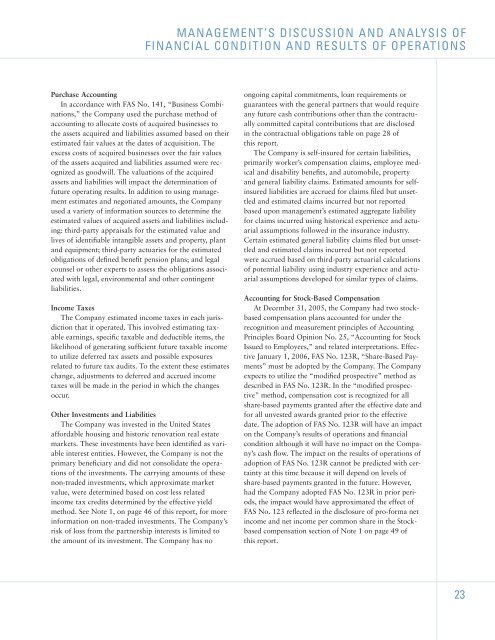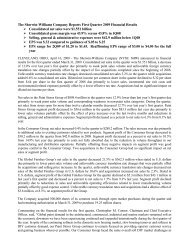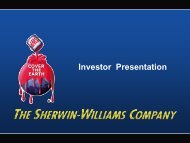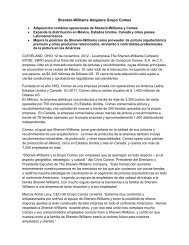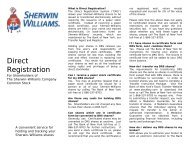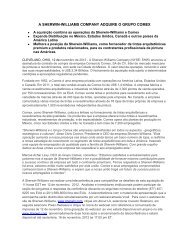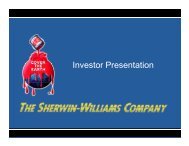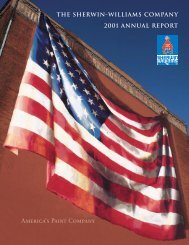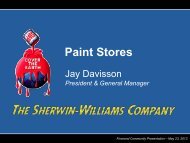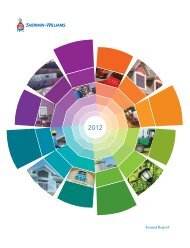2005 Annual Report - Investor Relations - Sherwin-Williams
2005 Annual Report - Investor Relations - Sherwin-Williams
2005 Annual Report - Investor Relations - Sherwin-Williams
You also want an ePaper? Increase the reach of your titles
YUMPU automatically turns print PDFs into web optimized ePapers that Google loves.
MANAGEMENT’S DISCUSSION AND ANALYSIS OF<br />
FINANCIAL CONDITION AND RESULTS OF OPERATIONS<br />
Purchase Accounting<br />
In accordance with FAS No. 141, “Business Combinations,”<br />
the Company used the purchase method of<br />
accounting to allocate costs of acquired businesses to<br />
the assets acquired and liabilities assumed based on their<br />
estimated fair values at the dates of acquisition. The<br />
excess costs of acquired businesses over the fair values<br />
of the assets acquired and liabilities assumed were recognized<br />
as goodwill. The valuations of the acquired<br />
assets and liabilities will impact the determination of<br />
future operating results. In addition to using management<br />
estimates and negotiated amounts, the Company<br />
used a variety of information sources to determine the<br />
estimated values of acquired assets and liabilities including:<br />
third-party appraisals for the estimated value and<br />
lives of identifiable intangible assets and property, plant<br />
and equipment; third-party actuaries for the estimated<br />
obligations of defined benefit pension plans; and legal<br />
counsel or other experts to assess the obligations associated<br />
with legal, environmental and other contingent<br />
liabilities.<br />
Income Taxes<br />
The Company estimated income taxes in each jurisdiction<br />
that it operated. This involved estimating taxable<br />
earnings, specific taxable and deductible items, the<br />
likelihood of generating sufficient future taxable income<br />
to utilize deferred tax assets and possible exposures<br />
related to future tax audits. To the extent these estimates<br />
change, adjustments to deferred and accrued income<br />
taxes will be made in the period in which the changes<br />
occur.<br />
Other Investments and Liabilities<br />
The Company was invested in the United States<br />
affordable housing and historic renovation real estate<br />
markets. These investments have been identified as variable<br />
interest entities. However, the Company is not the<br />
primary beneficiary and did not consolidate the operations<br />
of the investments. The carrying amounts of these<br />
non-traded investments, which approximate market<br />
value, were determined based on cost less related<br />
income tax credits determined by the effective yield<br />
method. See Note 1, on page 46 of this report, for more<br />
information on non-traded investments. The Company’s<br />
risk of loss from the partnership interests is limited to<br />
the amount of its investment. The Company has no<br />
ongoing capital commitments, loan requirements or<br />
guarantees with the general partners that would require<br />
any future cash contributions other than the contractually<br />
committed capital contributions that are disclosed<br />
in the contractual obligations table on page 28 of<br />
this report.<br />
The Company is self-insured for certain liabilities,<br />
primarily worker’s compensation claims, employee medical<br />
and disability benefits, and automobile, property<br />
and general liability claims. Estimated amounts for selfinsured<br />
liabilities are accrued for claims filed but unsettled<br />
and estimated claims incurred but not reported<br />
based upon management’s estimated aggregate liability<br />
for claims incurred using historical experience and actuarial<br />
assumptions followed in the insurance industry.<br />
Certain estimated general liability claims filed but unsettled<br />
and estimated claims incurred but not reported<br />
were accrued based on third-party actuarial calculations<br />
of potential liability using industry experience and actuarial<br />
assumptions developed for similar types of claims.<br />
Accounting for Stock-Based Compensation<br />
At December 31, <strong>2005</strong>, the Company had two stockbased<br />
compensation plans accounted for under the<br />
recognition and measurement principles of Accounting<br />
Principles Board Opinion No. 25, “Accounting for Stock<br />
Issued to Employees,” and related interpretations. Effective<br />
January 1, 2006, FAS No. 123R, “Share-Based Payments”<br />
must be adopted by the Company. The Company<br />
expects to utilize the “modified prospective” method as<br />
described in FAS No. 123R. In the “modified prospective”<br />
method, compensation cost is recognized for all<br />
share-based payments granted after the effective date and<br />
for all unvested awards granted prior to the effective<br />
date. The adoption of FAS No. 123R will have an impact<br />
on the Company’s results of operations and financial<br />
condition although it will have no impact on the Company’s<br />
cash flow. The impact on the results of operations of<br />
adoption of FAS No. 123R cannot be predicted with certainty<br />
at this time because it will depend on levels of<br />
share-based payments granted in the future. However,<br />
had the Company adopted FAS No. 123R in prior periods,<br />
the impact would have approximated the effect of<br />
FAS No. 123 reflected in the disclosure of pro-forma net<br />
income and net income per common share in the Stockbased<br />
compensation section of Note 1 on page 49 of<br />
this report.<br />
23


